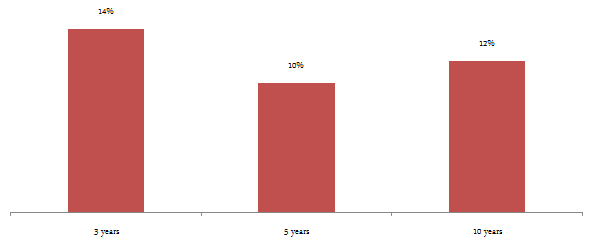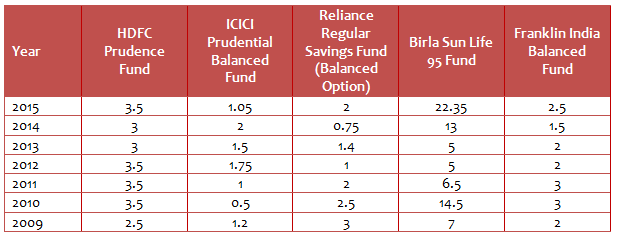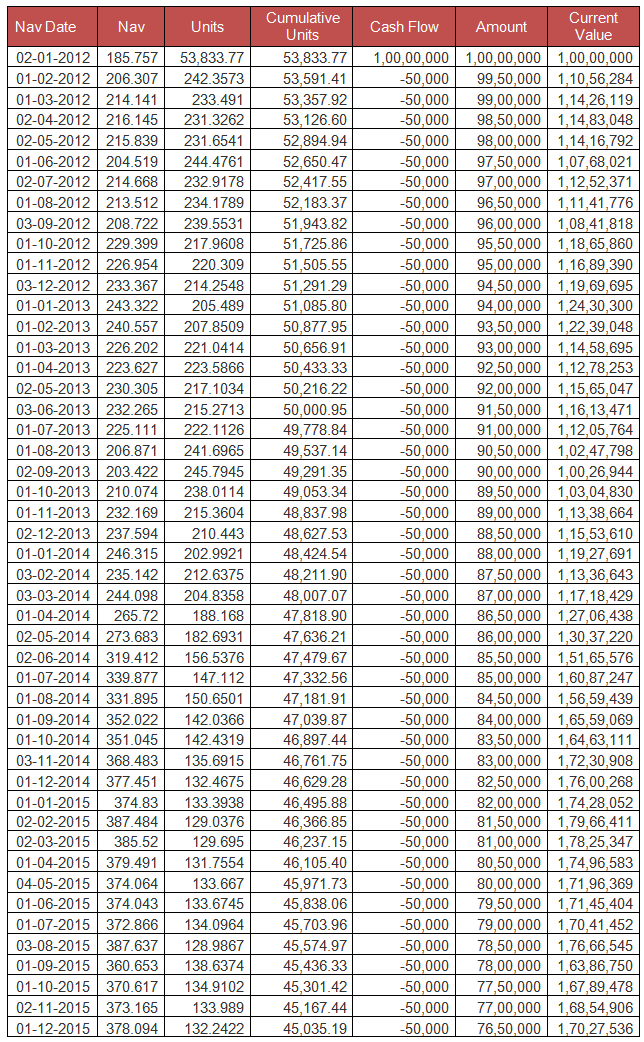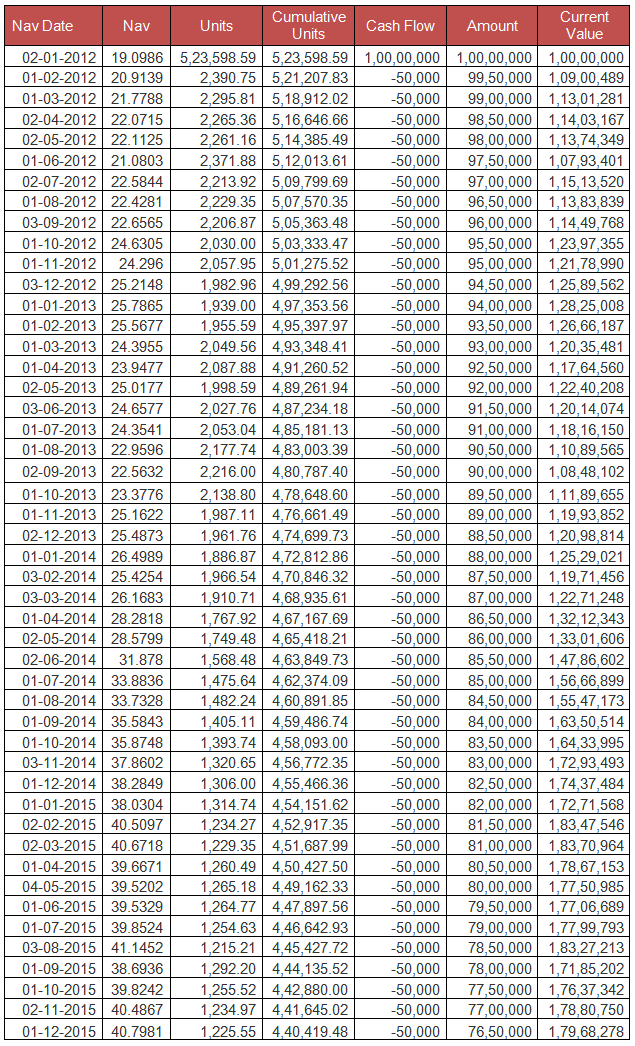SWP from balanced mutual funds is a smart option to get regular return

My childhood friend Nikhil had one lament for a long time. He said while there are many restaurants serving European cuisine in India, unfortunately there are not many options for vegetarians as far as European cuisine is concerned. His dream was to open a fine dining restaurant serving authentic vegetarian European cuisine. He also realized that even before he opens the restaurant, he would have to devote considerable time and effort to research and experimentation in his kitchen, so that he can come up with a large variety of vegetarian dishes while staying true to French or Italian style cooking. Nikhil had been mulling over this idea for many years and finally one summer evening in 2007, when Nikhil and I were chatting in my New Jersey apartment, he told me that he has made up his mind. By the end of 2010, he would quit his lucrative career as a patent lawyer in Washington DC and return to India to pursue his dream. Once he went back to India, Nikhil would devote the next two to three years to research and working in his kitchen, and then plan his restaurant in New Delhi. He asked me to help him plan his investments so that he could earn regular income from his investments till he starts to make money from his restaurant business. The capital required to start his business would come from inheritances that Nikhil and his wife, Vidya, received from their respective parents. So his investment goal was fairly simple, to get sufficient income to pay for their living expenses from 2010 onwards. I told Nikhil that we should treat his investment goal as retirement planning. Usually, there are three stages in retirement planning, an accumulation stage, a pre retirement stage and post retirement stage.
For the accumulation stage, we explored a number of options based on Nikhil and Vidya’s risk profiles, and zeroed down a few good diversified equity funds where they would start monthly SIPs immediately. 2008 was one of the most terrible years for equity markets, but it was a terrific year for Nikhil because he was able to invest in mutual fund units at rock bottom NAVs through Systematic Investment Plan route (you may check here - the SIP return of any Diversified Equity Mutual Funds since 2008). He also took advantage of the recession to tactically shift a portion of his assets from fixed income to equity funds. His SIPs and lump sum investments got him excellent returns by 2010. By 2010 Nikhil and Vidya accumulated enough investment corpus and started planning their relocation back to Delhi.
I reminded Nikhil and Vidya that they have now reached what in retirement planning parlance is known as pre-retirement stage. This is a stage where the investors should ensure that their finances are in place for upcoming retirement. Readers should keep in mind that accumulation and pre-retirement stages take place over many years. For Nikhil, the accumulation stage did not begin in 2007, but at least 10 years before that, when he started working and saving for retirement. The pre-retirement stage usually takes place over 5 to 10 years, but Nikhil and Vidya had to condense it within a year, because their goals were very aggressive. I told Nikhil and Vidya that, they should prepare a check-list which would include making sure they have adequate life and health insurance, contingency liquid funds and finally ensure that they start getting income from their investments. A portion of Nikhil and Vidya’s post retirement income would come from his fixed income interest and a portion from equity. Accordingly, Nikhil switched from growth to dividend options, so that he could get regular income from their equity funds.
In early 2011 Nikhil and Vidya relocated back to New Delhi from Washington DC. Finally they were in the post retirement stage. While this should be a very pleasant phase in the life of any investor, 2011 came as a rude shock to Nikhil and Vidya. The equity market fell by nearly 30%. Many equity funds that Nikhil and Vidya had invested in did not pay dividends that year. So they had to redeem some units of his funds to pay for their regular expenses. That coupled with mental stress associated with volatility was starting to impact them. Fortunately, Nikhil and Vidya had a large enough corpus. So their retirement planning was not in danger. Also, the market recovered in 2012; so no harm was done. However, I realized one mistake which Nikhil and Vidya made with respect to their investment planning during their pre-retirement stage. Even though, they were young, because they had no source of regular income other than their investments, they should have calibrated their asset allocation properly during the pre-retirement stage. Even though equities as an asset class, has the potential to give far superior returns in the long term compared to other asset classes, equities are intrinsically volatile in nature. On the other hand, investors need to have exposure to equities even during retirement so that they can beat inflation in the long term. Therefore, we need to have balanced approach. This is where balanced funds come in.
Balanced Funds are good investment options for moderate risk investors
Balanced Funds have 65 – 75% exposure to equities and 25 – 35% to debt. Long term capital gains (for an investment holding period of more than 12 months) from Balanced Funds are tax free. Dividends are also tax free. Balanced Funds are considerably less volatile than diversified equity funds. Volatility, as measured by annualized standard deviation of monthly returns, of Balanced Funds as a category is 10.25% over the last 3 years. Compare this with the volatility of Large Cap Equity Funds. The annualized standard deviation of monthly returns, of Balanced Funds as a category is 14.33% over the last 3 years. Small and midcap funds are even more volatile. While Balanced Funds are less volatile than diversified equity funds, they can beat inflation and give good returns over a sufficiently long time horizon. The chart below shows average trailing annualized returns from Balanced Fund as a category over the last 3, 5 and 10 years.

As such, Balanced Funds are diversified equity funds that Nikhil and Vidya had invested in, did not pay dividends in 2011. However, most good Balanced Funds paid dividends even in the bear market of 2011. The chart below shows the dividend history of some of the top Balanced Funds over the last 5 to 6 years.

Source: Advisorkhoj Research (Dividends in र / unit)
If Nikhil and Vidya had shifted their equity investments to Balanced Funds, they could have got some income from their investments even in the bear market of 2011. However, if we look at the figures in the table above, you will notice that the dividends paid by Balanced Funds can fluctuate from year to year. Investors should remember that mutual fund dividends are not assured, either with respect to the amount or the timing, or even the fact that they will paid at all. Investors should understand that mutual fund dividends are paid from the profit the scheme makes. SEBI regulations are quite clear on this matter. Therefore, if a scheme does not make a profit, it will not be able to pay dividend. So while mutual fund dividends can be used to supplement your regular income, but if you are relying on mutual fund dividends to meet your regular expenses, then you may face a challenge. But Nikhil and Vidya needed a regular income from their investment to meet their monthly expenses. Fortunately, mutual funds offer a solution.
Systematic Withdrawal Plan of Mutual Funds
In a Systematic Withdrawal Plans (SWP) you regularly withdraw a fixed amount of money from a fund. The amount to be withdrawn and the frequency of withdrawal are fixed by the investor. So you can have a monthly, quarterly or annual frequency for any fixed amount that you wish to receive. In an SWP you can draw a fixed amount, based on your income needs, at a frequency determined by you. SWP from a Balanced Fund (try this SWP Calculator) is an ideal investment option for investors to get monthly income from their investment and at the same time see their investment grow in value. Nikhil and Vidya needed an income of र 50,000 per month (figures are purely illustrative) from their mutual fund investment of र 1 crore. Mind you, if your income need is more than the average long term return of the fund, then you will end up exhausting your investment over time. In this case the annual income need was 6% of the investment amount. Over a long timescale, Balanced Funds have given a return of around 12%. Therefore, assuming these funds continue to give similar returns in the future, Nikhil and Vidya will not only be able to meet their monthly income needs, but also see capital appreciation.
For example, if they had invested र 1 crore in HDFC Prudence Fund in January 1, 2012 and started an SWP of र 50,000 per month, from the next month onwards, what would be their cash-flows and investment value today? The table below shows the cash flows and investment value.

Source: Advisorkhoj Research
You can see that, Nikhil and Vidya would have met their monthly income needs and at the same time see their investment grow in value from र 1 crore to र 1.7 crores. Not bad, considering that they would have been able to meet their monthly expenses and also see their investment almost close to double in value in less than 4 years.
Let us take another example, this time with Reliance Regular Savings Fund (Balanced Option).

Source: Advisorkhoj Research
Again, Nikhil and Vidya would have met their monthly income needs and at the same time see their investment grow in value from र 1 crore to र 1.8 crores. This is over and above the total withdrawal of र 23,50,000 that they have made over 4 years. You can see how effective SWP is in meeting your income needs and also growing your capital. Check Reliance Regular Savings Fund (Balanced Option – Growth Plan) – SWP Calculator
Before I suggested SWP to my friends, I decided to back test my hypothesis that SWP is an ideal option for generating monthly income and also capital appreciation. I selected Birla Sun Life 95 Fund to back test my hypothesis. Let us present the results till December 1, 2015 with a hypothetical started back in December 1, 2000, i.e. 15 years of data. With an investment of र 1 crore in Birla Sun Life 95 Fund and a monthly SWP of र 50,000 the investor would not only have met his or her income needs every month over the last 15 years, but also see their investment growing more 10 times in value from र 1 crore to more than र 10 crores (click on this link, Birla Sun Life 95 SWP over 15 years to see the results). The investment amount is not important. The SWP as a percentage of the investment amount and the investment horizon are the two most important factors. If your SWP in percentage terms is less than the long term expected return of the fund and if you have a long investment horizon, you will be able to meet your twin income and capital appreciation objectives.
Conclusion
In this blog we have seen how SWP from a balanced fund is a smart option to generate both monthly income and capital appreciation. If you need regular income from your investments, you can consult with your financial advisor, if SWP from a balanced fund is appropriate option for you. As far as Nikhil and Vidya are concerned, they have opened their restaurant on a small scale earlier this year. The early response has been fantastic and they are planning to open a bigger place very soon. As far as their personal finances are concerned, they are doing very well. Investment in good balanced funds and monthly SWP has worked out wonderfully for the couple.
Queries
-
What is the benefit of mutual fund STP
Aug 29, 2019
-
How much to invest to meet target amount of Rs 2 Crores
Aug 26, 2019
-
Can I achieve my financial goals with my current mutual fund investments
Aug 24, 2019
-
Can you tell me return of various indices
Aug 19, 2019
-
What would be the post tax return on different investments
Aug 18, 2019
-
Which Principal Mutual Fund scheme will be suitable for my retirement corpus
Aug 16, 2019
-
What is the minimum holding period for availing NCD interest
Aug 4, 2019
Top Performing Mutual Funds
Recommended Reading
Fund News
-
Kotak Mahindra Mutual Fund launches Kotak Nifty200 Value 30 Index Fund
Jan 15, 2026 by Advisorkhoj Team
-
Bandhan Mutual Fund launches Bandhan Silver ETF FOF
Jan 12, 2026 by Advisorkhoj Team
-
Bandhan Mutual Fund launches Bandhan Gold ETF FOF
Jan 12, 2026 by Advisorkhoj Team
-
The Wealth Company Mutual Fund launches The Wealth Company Gold ETF FOF
Jan 9, 2026 by Advisorkhoj Team
-
Mahindra Manulife Mutual Fund launches Mahindra Manulife Innovation Opportunities Fund
Jan 9, 2026 by Advisorkhoj Team














